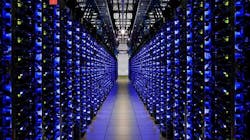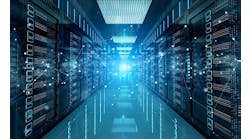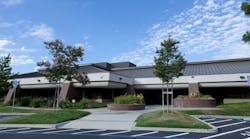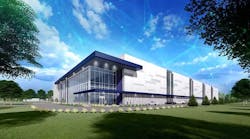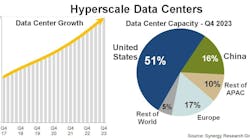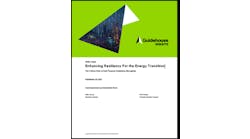SANTA CLARA. Calif. – Everywhere Steve Brown looks, he sees new technologies transforming our world. Brown envisions a future in which artificial intelligence, virtual reality, voice assistants, autonomous vehicles and robots will disrupt nearly every aspect of our economy. A growing universe of connected things will send huge amounts of data across ultra-fast wireless connections, all converging on the data center.
“A lot of the fabric of modern life is fully reliant on data centers,” said Brown, the former Chief Evangelist and Futurist at Intel. “There are going to be huge new workloads and huge new demands on the data center.”
Brown, who is now the CEO at Bald Futurist, addressed the critical role the data center industry will play in the coming technology revolution in a keynote at the recent Open Compute Summit. Speaking to a room full of technologists building hyperscale infrastructure, Brown reinforced the need for data centers to scale to scale for the coming data deluge.
“You’re going to see a lot more smart devices and smart spaces,” said Brown. “We’re going to be seeing a lot more endpoints” sending information into data centers.
In nearly two decades at Intel, Brown saw first-hand how new technologies can evolve and have global impact. He’s one of the creators of the ATX motherboard form factor, which became the global standard for the PC industry. Not surprisingly, his projections align with Intel’s vision for a data-driven world with the data center at its center.
“You can see that the capabilities of the cloud and the data center will expand over time,” he said. “You can expect to see new and expanding workloads in the data center.”
In his talk at Open Compute, Brown outlined the multiple ways in which emerging technologies will drive growth for the data center industry.
Artificial Intelligence and Robots:
The hyperscale sector’s massive investment in machine learning will create services that will enable advances in applications for both industries and consumers.
Steve Brown, the former Chief Evangelist and Futurist at Intel, describes the transformative impact of new technology during a keynote at the Open Compute Summit in Santa Clara. (Photo: Rich Miller)
“With AI and machine vision, we are making leaps forward, and you’re starting to see more advanced robots and autonomous machines,” said Brown. “It’s no longer ‘robots one day.’ It’s ‘robots next week.’ These robots will be sensing the world, and talking to each other. Their data has to go somewhere. This will place a load on the data center. Massive amounts of data will be spurting out of these autonomous machines so we can learn about them and train them.”
Brown is among those who see voice interfaces as an ascendant trend, predicting that Apple’s Siri and Amazon’s Alexa are the first wave in a broader trend of virtual assistants that can hold conversations. “We’re moving toward a voice first world,” said Brown. “This is clear.”
He noted a Gartner projection that 20 percent of smartphone interactions will be voice driven by 2019. Many businesses will embrace “conversation as a service” – voice-enabled interfaces field requests for new services.
Virtual and Augmented Reality
As we’ve previously noted, the emergence of virtual reality (VR) and augmented reality (AR) as mass-market technologies would place enormous demand on wireless and data center infrastructure. Although current adoption of VR and AR remains limited, Brown believes the technologiy and product offerings will improve rapidly to create a compelling, immersive experience.
“VR and AR are currently in their infancy,” he said. “You will see virtual reality and augmented reality become the primary digital interface. This will change the demands on the data center.”
Brown is particularly keen on the disruptive potential for volumetric 3D video, which employs multiple cameras and LIDAR (Light Detection and Ranging, a sensing method that uses a pulsed laser to measure distance) to create an experience akin to the Star Trek Holodeck. Here’s a look:
The challenge is that volumetric 3D video requires 3GB of data per frame. Yes, per frame.
“Think about the demand as you try to stream volumetric VR from the data center,” said Brown. “It’s going to be quite a lot of demand.”
Wireless and 5G
As endpoints multiply and become distributed, ultra-fast wireless will super-size the capacity of data moving across the network to data centers for analysis and storage. The coming 5G wireless standard, which is currently under development, will dramatically accelerate wireless connections. When 5G arrives, Brown predicts it will lead to a proliferation of “dumb end points” – devices that are low-tech but use connections to cloud platforms to deliver high-value services.
“Why put the intelligence in the device if you can access it at high speed over a wireless connection?” said Brown. “You’ll see a lot more dumb end points, because latency to the cloud is simple.”
As an example, Brown pointed to educational products from Cognitoys, which leverage speech recognition capabilities of the IBM Watson cloud to allow plastic dinosaur toys to conduct educational conversations with children. Here’s a look:
“When 5G comes, we’ll see more endpoints like this,” said Brown. “With the reduced latency, the cloud moves closer to the edge, and you’re much more likely to use the cloud” to bring intelligence to products and services.
The Road Ahead
At Data Center Frontier, we track how these technologies will impact the data center. We write about what’s next for the Internet, and the innovations that will take us there. Brown’s presentation at Open Compute builds upon many of our expectations about the future, and he emphasizes that the transformation will impact businesses as well as consumers.[clickToTweet tweet=”Steve Brown. You have a big challenge, but it’s an exciting one. The world economy is standing on your shoulders.” quote=”Steve Brown. You have a big challenge, but it’s an exciting one. The world economy is standing on your shoulders.”]
“I would contend that every business in the world is becoming mission critical,” said Brown. “Every company will be a data company, because if they don’t, they aren’t going to be competitive. You will see a lot of industries gathering more information and analyzing more data about their customer.
“The types of computing are changing,” he added. “Being able to embrace new architectures and bring them into the data center will be critical. The workload growth the data center community is facing is enormous.”
This future will challenge the data center community’s ability to scale and keep pace with demand for compute and storage capacity. But Brown believes that this contains a great opportunity as well.
“You have a big challenge, but it’s an exciting one,” said Brown. “The world economy is standing on your shoulders. You’ll have many new businesses that need to come and use your type of businesses. The world is going to look to you for help and to interact with technology in whole new ways.”
